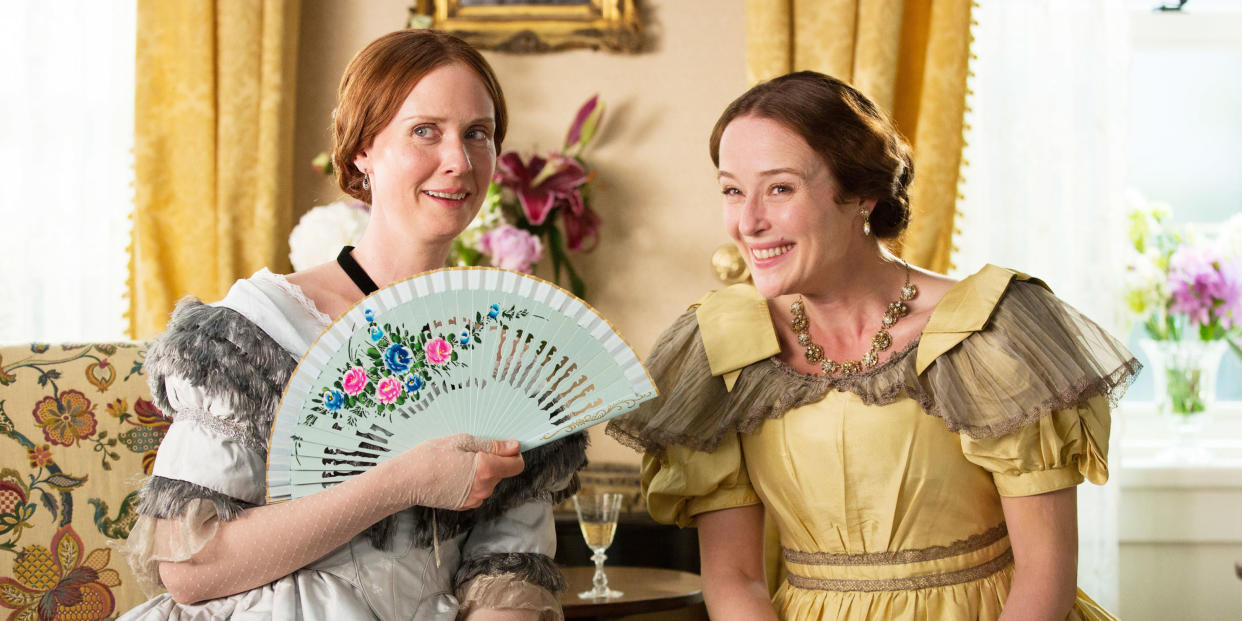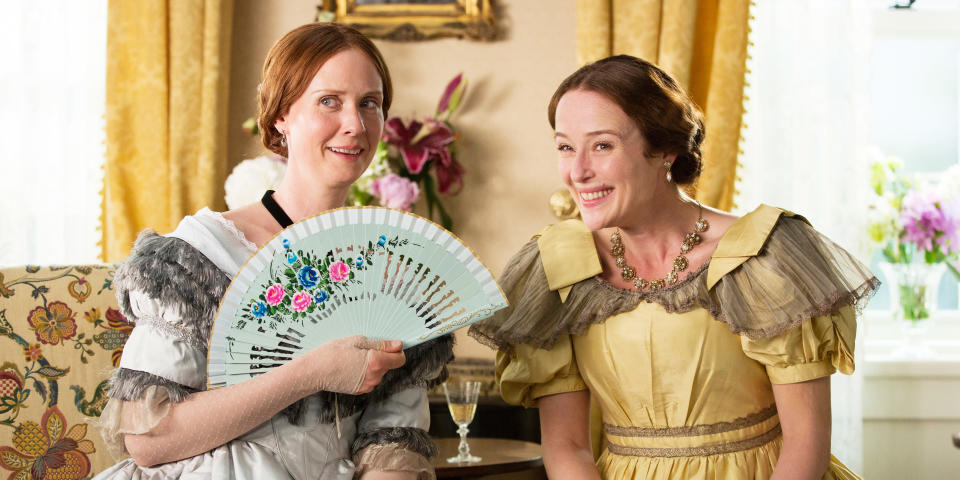Why Do We Want Emily Dickinson to Be a Feminist Hero So Badly?

Every age gets the Emily Dickinson it needs. This, anyway, is the conclusion I came to when watching A Quiet Passion, Terence Davies' biopic of the poet. In 2017, Emily (Cynthia Nixon) is a rebel, refusing to be "saved" by embracing Christ, and being lectured for it by her teacher at the Mount Holyoke Female Seminary. At home, she inveighs against slavery and makes overt proto-suffragist statements, like "Every fight about gender is a war, for that, too, is slavery." Emily trades jokes with a friend about boring men and the suffocating conformity of her hometown; she also has body image problems-lamenting her homeliness, sometimes accompanied by wrenching sobs-and professional ambition.
This woman is immensely likeable. She is also not Emily Dickinson.
This isn't a diss on A Quiet Passion. It's a beautiful movie, and deeply moving. But it's startling to see Emily Dickinson-a woman who hid nearly 2,000 poems in her bedroom, and complained when a friend got one published without her permission-bewailing the fact that she may "never accomplish anything." One review calls the character "too smart for her entire era, like a stranded time traveler." But she is a time traveler, because she is, essentially, a twenty-first century woman written into a nineteenth century context: An agnostic, feminist skeptic trying to make it in a man's world. This woman is immensely likeable. She is also not Emily Dickinson.

But then, neither are any of the Emily Dickinsons we've constructed over the years. Dickinson gave us 1,800 abstract poems, all attesting to a painfully intense inner life, but practically nothing in the way of concrete autobiography. Take "He fumbles at your Soul":
He fumbles at your Soul
As Players at the Keys-
Before they drop full Music on-
He stuns you by Degrees-
In Davies' film, this poem accompanies a doctor giving Emily a terminal diagnosis, which works. I've also seen it explained as an account of a rape, or a BDSM submissive's fantasy about being topped, or a first-hand description of a seizure, or the writer being visited by God. Dickinson's poem gives us the full intensity of her experience. But we don't know what she was experiencing.
It's inevitable that readers would try to fill this void. In the 1950s, critic Jay Leyda framed the core question like so: "Is it really possible that we can be shut away from the full work or the real personality of so vital a poet?" He was determined to find "the real person who wrote those real poems." Yet that "real personality" has shifted with every biographer or critic to take her on: We've met Emily Dickinson the twee child-woman, Emily Dickinson the crazy love-starved recluse, Emily Dickinson the feminist rebel, Emily Dickinson the invalid, Emily Dickinson the saint.

Dickinson was not above cultivating her mystique. This is a woman who was commonly referred to as "the Myth," even when she was alive. It was a family friend, Mabel Loomis Todd, who gave us many of the myth's core elements: "I must tell you about the character of Amherst," she wrote to a friend. "She is a sister of Mr. Dickinson, and seems to be the climax of all the family oddity. She has not been outside her own house in fifteen years, except once to see a new church, when she crept out at night & viewed it by moonlight...She writes finely, but no-one ever sees her."
The image of a creepy, ghostlike Emily was one Todd doubled down on when she gave a private concert in the Dickinson family home and Emily refused to attend: "It was odd to think, as my voice rang out through the big silent house that Miss Emily in her weird white dress was outside in the shadow hearing every word." By that time, Todd also had a backstory for Dickinson, including a love affair that explained her strangeness: "She is very brilliant & strong, but became disgusted with society & declared she would leave it when she was quite young. It is hinted that Dr. Holland loved her very much & she him, but that her father who was a stern old New England lawyer & politician saw nothing particularly promising or remarkable in the boy, & would not listen to her marrying him."
There's just one problem with this story: It might have been made up. Generations of scholars have tried to establish that Dickinson's reclusive tendencies were due to a failed love affair; no one has ever been able to establish Holland, or any other man, as the culprit. The bit about a heartbroken woman retreating from society and wearing the same white dress for the rest of her life is straight from Great Expectations, which Todd referred to in her letter: "One inevitably thinks of Miss Haversham [sic] in speaking of her." In fact, Emily Dickinson hated Mabel Loomis Todd; she was sleeping with Dickinson's brother, whose wife Sue happened to be Emily's best friend. Dickinson was probably snubbing an unwelcome guest; Todd turned it into a scene from a horror movie.

Yet it was Todd's account that defined Dickinson for years; by the 1950s, critics were bemoaning the loner-in-white cliché of "Our Emily." Todd also went on to publish heavily bowdlerized versions of Emily's poems, prioritizing sweet reflections on nature over gory stuff like "He fumbles at your Soul," which resulted in Dickinson being seen for decades as a minor poet: an innocent, childlike virgin who wrote about springtime and bumblebees.
Even when the true poems were published in full, in the mid-twentieth century, the battle to define Dickinson persisted. Next, instead of being a harmless spinster, Dickinson was characterized as a lunatic. In 1971, John Cody wrote an entire book casting Dickinson as a damaged outcast whom bad parenting and a lack of sexual experience drove insane. To this day, people speculate that Dickinson had bipolar disorder or epilepsy, despite a lack of evidence.
Feminists defended Dickinson, but generally by granting her explicitly feminist politics and the ability to see the future, namely her own fame: "Dickinson chose her seclusion, knowing she was exceptional and knowing what she needed," wrote Adrienne Rich, in "Vesuvius at Home," her famous essay about the poet. This new Dickinson, at least, was a functioning adult. Queer feminists also resolved one of the more vexing questions-how a woman who'd supposedly never had sex managed to write torrid sexual poems like "Wild Nights"-by pointing to her passionate, and often suggestive, letters to Sue. References to sex would surely need to be heavily veiled, if her sister-in-law were her lover.

In A Quiet Passion, Davies adheres to the myth, or rather, to several of them: His Dickinson is a lonely virgin who wears nothing but white, but she has feminist spunk and literary ambition. She fantasizes about men, but also has intense late-night conversations with Sue about "the physical part of marriage." The film is only doing what we've always done with Emily: Explaining away the inexplicable, trying to pull her astonishingly unique mind closer to our world by making her more like us.
The Myth of Emily Dickinson may be just another one of Emily Dickinson's great artistic creations.
But then, maybe she was more like us than we know. In recent decades, Dickinson scholars have focused on the fact that Emily was almost, shockingly, normal. No, she didn't go out, but she had many friends-she just preferred writing letters to in-person socializing, which anyone who spends too much time on Facebook can understand. Yes, she said odd things, but that was because she had a sense of humor. And, though the question of her sexuality remains open, we know that she did not die lonely: She had a happy relationship with Judge Otis Lord until his death, two years before her own.
Which brings us to the surprising-though not unpleasant-realization that the myth of Emily Dickinson may be just another one of Emily Dickinson's great artistic creations. At the center of it all, under the layers of spooky stories and white dresses and otherworldly poems, may have been an entirely ordinary, happy woman, who managed to protect her privacy and her artistic freedom by transforming herself into a legendary figure. Maybe that Emily Dickinson-the artist, hard at work, eluding our unwelcome questions-is the feminist heroine worth remembering.
You Might Also Like
